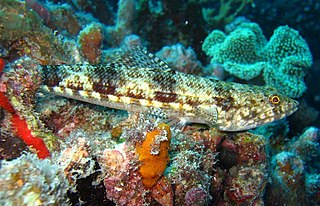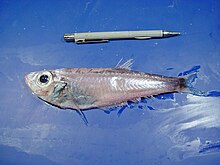
Clupeiformes is the order of ray-finned fish that includes the herring family, Clupeidae, and the anchovy family, Engraulidae. The group includes many of the most important forage and food fish.

Herring are various species of forage fish, mostly belonging to the family of Clupeidae.

Aulopiformes is a diverse order of marine ray-finned fish consisting of some 15 extant and several prehistoric families with about 45 genera and over 230 species. The common names grinners, lizardfishes and allies, or aulopiforms are sometimes used for this group. The scientific name means "Aulopus-shaped", from Aulopus + the standard fish order suffix "-formes". It ultimately derives from Ancient Greek aulós + Latin forma, the former in reference to the elongated shape of many aulopiforms.

Antigonia is a genus of marine ray-finned fish belonging to the family Caproidae, the boarfishes. This genus is found in the warmer oceans around the world and is the only extant genus in the subfamily Antigoniinae.

The Australian herring, also known as the ruff, tommy ruff, or Australian ruff, is one of four Australasian fish species within the genus Arripis. It closely resembles its sister species, the Australian salmon, although it grows to a smaller size. Like the other members of its genus, it is found in cooler waters around the southern coast of Australia. It is not biologically related to the herring family Clupeidae.

The Synodontidae or lizardfishes are benthic (bottom-dwelling) marine and estuarine bony fishes that belong to the aulopiform fish order, a diverse group of marine ray-finned fish consisting of some 15 extant and several prehistoric families. They are found in tropical and subtropical marine waters throughout the world.

Bathyclupeidae is a family of acropomatiform ray-finned fish, called deep sea herrings. They are marine fishes found in tropical waters of the Atlantic Ocean, Gulf of Mexico, Indian Ocean and Pacific Ocean. They grow up to about 20 cm long.

Glaucosoma, the pearl perches, are ray-finned fishes native to the Indian Ocean waters around Australia and the western Pacific Ocean. This genus is currently the only one assigned to the family Glaucosomatidae.

The Bathysauridae are a small family of deepwater aulopiform fish, related to the telescopefishes. The two species in the family both belong to the genus Bathysaurus. Commonly called deepwater lizardfishes or deepsea lizardfishes, the latter name usually refers to the species B. ferox specifically.

Black seadevils are small, deepsea lophiiform fishes of the family Melanocetidae. The five known species are all within the genus Melanocetus. They are found in tropical to temperate waters of the Atlantic, Indian, and Pacific Oceans, with one species known only from the Ross Sea.

Halieutopsis is a genus of marine ray-finned fishes beloning to the family Ogcocephalidae, the deep sea batfishes. The species in this genus are found in the Indian and Pacific Oceans.
Aristostomias is a genus of barbeled dragonfishes native to the ocean depths in the Pacific, Atlantic and Indian oceans.
Pachystomias microdon, the smalltooth dragonfish, is a species of barbeled dragonfish found in the oceans at depths of from 660 to 4,000 metres. This species grows to a length of 22.1 centimetres (8.7 in) SL. This species is the only known species in its genus.
Photonectes is a genus of fish in the family Stomiidae found in Atlantic, Indian and Pacific Ocean.

Oneirodes is a genus of is a genus of marine ray-finned fish belonging to the family Oneirodidae, the dreamers, a family of deep sea anglerfishes. These predatory, deep-sea fishes are found around the world. This is the type genus, and the most speciose genus, of the family Oneirodidae. They are sexually dimorphic but, like most taxa within their family, the small males are free living and are not sexual parasites on the larger females. Only the females are used to identify the species in this genus as no species specific charaxcters have been found for males.

Acropoma is a genus of ray-finned fish in the family Acropomatidae, the temperate ocean-basses or lanternbellies. They are native to the Indian Ocean and western Pacific Ocean. They are characterized by a ventral luminous organ that has a luminous gland, a lens, and a reflector. The shape of the luminous organ helps distinguish the species in the genus.

Neobathyclupea is a genus of ray-finned fish in the family Bathyclupeidae found in the Atlantic, Indian and Pacific Ocean.

Paracombrops is a genus of marine ray-finned fishes from the family Synagropidae. The fish in this genus are found in the Indo-Pacific.
Neobathyclupea melanoptera is a species of ray-finned fish in the family Bathyclupeidae found off Myanmar

The Tropical lanternbelly, Acropoma leobergi is a species of the genus Acropoma described as having a luminous behind the anus that resembles a "U" in shape. The species is native to the Arafura Sea.















